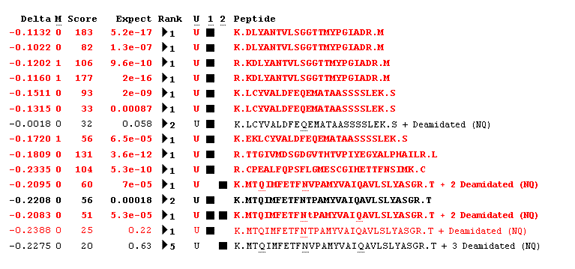Exercise MSMS2: answers
- Do you get better sensitivity at a given FDR using the identity threshold or the homology threshold?
For an FDR of 1%, it seems like the sensitivity is slightly better using the homology threshold.
Using the example search results
the homology threshold gives 694 matches at 1% FDR while the identity threshold gives 672. The picture is similar
for an FDR of 5%
- Do you get better sensitivity searching the whole of SwissProt or just the human entries?
A taxonomy filter of Homo sapiens gives the best sensitivity. Increasing the search space doesn’t bring in any
new matches, so the sensitivity at a given FDR gets worse
- Do you think there is evidence for both ACTB_HUMAN and ACTA_HUMAN?
The only high scoring match in ACTA_HUMAN that is not present in ACTB_HUMAN is K.MTQIMFETFNVPAMYVAIQAVLSLYASGR.T
However, notice that there is a slightly lower scoring match to a very similar peptide in ACTB_HUMAN. The difference is
just a V in ACTA_HUMAN substituted by a T in ACTB_HUMAN. The V is 2 Da lighter, but this is balanced by addding two deamidations,
and the modified peptide gets a slightly higher score. This slight increase in score is not sufficient evidence for the
presence of ACTA_HUMAN

- How many proteins are you confident are present in this sample?
Load the
example search results
and set the FDR for the homology threshold to 1%. Follow the link to the decoy report and switch to the report builder tab.
The 6 false peptide matches each give rise to a false (one hit wonder) protein, but if we applied a rule that a protein had to have significant
matches to at least 2 sequences, then there would be no false proteins. Return to the original report
and select the report builder tab. Add a filter that requires each protein to have significant
matches to at least 2 sequences. The number of proteins that remains is 86, and we can be reasonably confident that none of
these are false.
Return to exercise page
